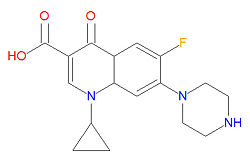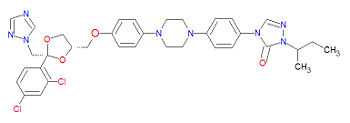CZ:Chemistry style guide: Difference between revisions
imported>David E. Volk (→Chem infobox and Elem Infobox: example text for chem infobox) |
imported>David E. Volk (Full text examples of chem and elem infoboxes for quick copy/paste) |
||
| Line 24: | Line 24: | ||
To make your own chem infobox, just '''copy this text''' and change the variables as appropriate. The example text below provide the chem infobox for itraconazole shown below. | To make your own chem infobox, just '''copy this text''' and change the variables as appropriate. The example text below provide the chem infobox for itraconazole shown below. | ||
'''The Chem infobox for [[Itraconazole]] (at right) is made from this text:'''<br><br> | |||
{{Chem infobox | {{Chem infobox | ||
|align= | |align=right | ||
|image=[[Image:Itraconazole structure.jpg|center|350px|thumb|{{#ifexist:Template:Itraconazole structure.jpg/credit|{{Itraconazole structure.jpg/credit}}<br/>|}}Itraconazole, a triazole-based antifungal agent.]] | |image=[[Image:Itraconazole structure.jpg|center|350px|thumb|{{#ifexist:Template:Itraconazole structure.jpg/credit|{{Itraconazole structure.jpg/credit}}<br/>|}}Itraconazole, a triazole-based antifungal agent.]] | ||
|width=350px | |width=350px | ||
| Line 57: | Line 42: | ||
}} | }} | ||
<nowiki>{{Chem infobox</nowiki><br> | |||
<nowiki>|align=right </nowiki><br> | |||
<nowiki>|image=[[Image:Itraconazole structure.jpg|center|350px|thumb|{{#ifexist:Template:Itraconazole structure.jpg/credit| | |||
{{Itraconazole structure.jpg/credit}}<br/>|}}Itraconazole, a triazole-based antifungal agent.]] </nowiki><br> | |||
<nowiki>|width=350px</nowiki><br> | |||
<nowiki>|molname=itraconazole </nowiki><br> | |||
<nowiki> |synonyms= itraconazol, itraconazolum </nowiki><br> | |||
<nowiki>|molformula= C<sub>35</sub>H<sub>38</sub>C<sub>l2</sub>N<sub>8</sub>O<sub>4</sub> </nowiki><br> | |||
<nowiki> |molmass= 705.6334 </nowiki><br> | |||
<nowiki> |uses=antifungal drug </nowiki><br> | |||
<nowiki> |properties=triazole compound </nowiki><br> | |||
<nowiki> |hazards=see drug interactions </nowiki><br> | |||
<nowiki> |iupac= see chemistry section </nowiki><br> | |||
<nowiki> |casnumber=84625-61-6 </nowiki><br> | |||
<nowiki> }} </nowiki><br> | |||
| Line 76: | Line 77: | ||
'''The Elem_Infobox for [[Phosphorus]] (at right) is made from this text:'''<br><br> | |||
{{Elem_Infobox | {{Elem_Infobox | ||
|background1=ffffff | |background1=ffffff | ||
| Line 94: | Line 96: | ||
|hazard= flammable, toxic | |hazard= flammable, toxic | ||
}} | }} | ||
<nowiki>{{Elem_Infobox </nowiki><br> | |||
<nowiki>|background1=ffffff </nowiki><br> | |||
<nowiki>|elementColor=ffe303 </nowiki><br> | |||
<nowiki>|elName=Phosphorus </nowiki><br> | |||
<nowiki>|elMass=30.973761 </nowiki><br> | |||
<nowiki> |elClass=Non-Metal </nowiki><br> | |||
<nowiki> |elSym=P </nowiki><br> | |||
<nowiki> |elNum=15 (this is the atomic number) </nowiki><br> | |||
<nowiki> |eltrnCfg=1''s''<sup>2</sup>2''s''<sup>2</sup>2''p''<sup>6</sup>3''s''<sup>2</sup>3''p''<sup>3</sup> </nowiki><br> | |||
<nowiki>|no1= +3 (these are common oxidation states) </nowiki><br> | |||
<nowiki> |no2= +5 </nowiki><br> | |||
<nowiki>|no3= 0 </nowiki><br> | |||
<nowiki>|no4= -3 </nowiki><br> | |||
<nowiki>|properties=allotropic </nowiki><br> | |||
<nowiki>|compounds=Oxides, oxyacids, halides </nowiki><br> | |||
<nowiki>|uses=Vital to life; fertilizers; pesticides; acids; drying agents </nowiki><br> | |||
<nowiki>|hazard= flammable, toxic </nowiki><br> | |||
<nowiki>}} </nowiki><br> | |||
{{-}} | {{-}} | ||
Revision as of 21:35, 14 April 2011
This page is the first draft of style guide for chemistry articles, with sections detailing how to write equations, make arrows, which subsections to include for chemistry and for drug articles, the use of color and other topics. This page is a work-in-progress, so chemistry editors, authors and other Citizens should feel free to add addtional comments and make corrections. This is basically a wish list, so if you don't know how to do everything, don't worry about it, someone else will come along and help out.
Chemical Elements and their isotopes
We aim for articles on chemical elements to have an element infobox. See Phosphorus, Hydrogen or Nitrogen for illustrations. We strive for completely filled in boxes, which is why some Citizens in the chemistry workgroup keep a special eye on them. So, if you don't know how to handle the infobox don't worry, someone else may take care of it. We don't list all the isotopes of an element, neither in the infobox nor on the main page, because many elements have dozens of isotopes. We list only a few of the most common and best known isotopes on the main page. For instance, you will find the isotopes deuterium, tritium and carbon-14, which are widely used in the sciences, on their respective main pages. Other less well-known isotopes are listed on special subpages. We also try to fill in as much as possible the hazards in the element infobox, particularly for radioactive elements. But if you don't know any hazards, remember CZ is a wiki, it may be filled in later either by you or by someone else.
Naming (IUPAC) of articles for chemical compounds
When widely used, common names should be used for the article titles of chemical compounds.
Thus, use methanol and ethanol rather than hydroxymethane or hydroxyethane. Also create articles called hydroxymethane and hydroxyethane and use a redirects to the existing article. The official chemical name according to the IUPAC[1] should be included somewhere in the article, but not necessarily at the top. If the name is not too long, include it in the Chem infobox template.
Chemical drawings: color, fonts and image sizes
When drawing chemical structures in which color is used, color oxygen atoms red and nitrogen atoms blue. Sulfur should be colored green. Shades of magenta, orange, tan and brown may be used for other atoms. Chemical structures are not required to use color other than black.
Within the article, unless the compound is very large, set the pixilation size in the range of 100-350, preferably 200-250. Use a font size of 18 for most structures, and sizes smaller than 14 should be avoided to enable easy reading by all users.
Molecular weight and formula
The molecular weight and chemical formula of the compound should be found in the article.
Chem infobox and Elem Infobox
A template, called Template:Chem infobox should be used to display data for chemical compounds. A similar templated called Template:Elem Infobox should be used for chemical elements. Below are examples taken from Itraconazole and Phosphorus.
To make your own chem infobox, just copy this text and change the variables as appropriate. The example text below provide the chem infobox for itraconazole shown below.
The Chem infobox for Itraconazole (at right) is made from this text:
|
| |||||||
| itraconazole | |||||||
| |||||||
| Uses: | antifungal drug | ||||||
| Properties: | triazole compound | ||||||
| Hazards: | see drug interactions | ||||||
| |||||||
{{Chem infobox
|align=right
|image=[[Image:Itraconazole structure.jpg|center|350px|thumb|{{#ifexist:Template:Itraconazole structure.jpg/credit|
{{Itraconazole structure.jpg/credit}}<br/>|}}Itraconazole, a triazole-based antifungal agent.]]
|width=350px
|molname=itraconazole
|synonyms= itraconazol, itraconazolum
|molformula= C<sub>35</sub>H<sub>38</sub>C<sub>l2</sub>N<sub>8</sub>O<sub>4</sub>
|molmass= 705.6334
|uses=antifungal drug
|properties=triazole compound
|hazards=see drug interactions
|iupac= see chemistry section
|casnumber=84625-61-6
}}
The Elem_Infobox for Phosphorus (at right) is made from this text:
| |||||||||||||||||||||||||||||||||||||||||||||||||||||||||||||||||||||||||||||||||||||||||||||||||||||||||||||||||||||||||||||||||||||||||||||||||||||||||||||||||||||||||||||||||||||||||||||||||||||||||||||||||||
{{Elem_Infobox
|background1=ffffff
|elementColor=ffe303
|elName=Phosphorus
|elMass=30.973761
|elClass=Non-Metal
|elSym=P
|elNum=15 (this is the atomic number)
|eltrnCfg=1''s''<sup>2</sup>2''s''<sup>2</sup>2''p''<sup>6</sup>3''s''<sup>2</sup>3''p''<sup>3</sup>
|no1= +3 (these are common oxidation states)
|no2= +5
|no3= 0
|no4= -3
|properties=allotropic
|compounds=Oxides, oxyacids, halides
|uses=Vital to life; fertilizers; pesticides; acids; drying agents
|hazard= flammable, toxic
}}
Stereochemistry
Whenever possible, use solid wedges (up) and dashed wedges (down) to include stereochemistry of the compound whenever such information is available. Some compounds, like steroids and cholesterol, also use alpha and beta to denote stereochemistry. When applicable, say for a particular drug that is a steroid-mimic, this information should be included in the article for completeness, particularly in the IUPAC name of the chemical.
Typical subsections to use
- Introductory paragraph (not labeled as subsection, similar to all CZ intros)
- Physical Properties
- Synthesis & Typical Reactions
- History - including discovery
- Warnings
- Industrial manufacture
See the #Articles about drugs subsection below for extra subsections typically included for articles about drugs.
Chemical equations
A few examples of widely used chemical reactions for the compound should be displayed. Chemical reactions should be explained both in the text and with the use of equations. Examples of wikitext and the resulting equations created are illustrated below. Just copy & paste the relevant text.
How to make arrows
Some arrows can be inserted by clicking on the appropriate arrow located on the bottom of edit pages. They can also be typed as shown by the examples below. Note that the math begin (<math>) and math end (</math>) tags do not need to immediately surround the arrow functions, they only need to be at the beginning and end of equations.
is made from <math>\rightarrow</math> or <math>\rarr</math> or →
is made from this <math>\leftarrow</math> or <math>\larr</math> or ←
is made from this <math>\leftrightarrow</math> or <math>\harr</math> or ↔
is made from <math>\stackrel{\textstyle \leftarrow}{\rightarrow} </math>
is made from this <math>\uparrow</math>
is made from this <math>\downarrow</math>
Equation example 1 (Roman lettering)
Note that buttons for superscripts and subscripts are located immediately above and below the edit text box when editing a page. To subscript something, just hi-light the text and click the subscript button.
This text
: 4NaPO<sub>3</sub> + 2SiO<sub>2</sub> + 10C → 2Na<sub>2</sub>SiO<sub>3</sub> + 10CO + P<sub>4</sub>
OR THIS TEXT
:<math> 4 \mathrm{NaPO}_3 + 2 \mathrm{SiO}_2 + 10\mathrm{C} \rarr 2 \mathrm{Na}_2\mathrm{SiO}_3 + 10\mathrm{CO} + \mathrm{P}_4 </math>
provides the following equation (note that colons indent the equation)
- 4NaPO3 + 2SiO2 + 10C → 2Na2SiO3 + 10CO + P4
Equation example 2 (italic variables for math equations)
This text
[[van der Waals equation]] :<math>\left(p + \frac{n^2 a}{V^2}\right)\left(V-nb\right) = nRT</math>
provides this mathematic formula
Greek symbols
Greek symbols can be inserted by clicking on the appropriate symbol located at the bottom of every "edit" page.
Alternatively, they be coded in directly using LaTex like so:
<math>\alpha</math>-[[amino acid]]s gets converted to: -amino acids.
Greek letters can also be made in HTML, see for a list here.
Articles about drugs
Articles about drugs should include the following extra data, when available. The article ketoconazole is an example a drug article with complete information (except dosing)
Sections to include:
- Image of the structure , following rules listed above.
- Chemistry
- This section can be used for the MW, chemical formula, IUPAC name and other data
- Mechanism of action
- - This section might also include metabolism, especially for prodrugs
- Drug interactions
- - In particular, dangerous drug combinations need to be listed in either paragraph or list form.
- Synomyms
- - combine with Brand names if both lists are fairly short
- Brand names
- - Be sure to append the ® symbol on the right side of each name.
- Dosing???
- At present, dosing information has not been generally included. This may change after discussion.
- External links
- The following three templates, or their combination ({{CZMed}}) should be included for all drug pages- Include links to
- The following three templates, or their combination ({{CZMed}}) should be included for all drug pages- Include links to
- {{DailyMed}}
- {{MedMaster}}
- {{Drug Bank}}.
or alternatively, the template {{CZMed}} acts likes the above three templates put together.
See Ketoconazole or Atazanavir for an example article. Unlike other articles, we put these links on the main page because they will contain the most up-to-date data available.
Presently, this data is all located on the main page, but might be moved to subpages in the future. For newer drugs with only one brand name or synonym, these data should be in the introductory paragraph. The "drug class", such as statins, antivirals, or protease inhibitors, and very related drugs or natural compounds, should be mentioned.
Explosives
Articles dealing with explosive compounds, unstable chemicals, and dangerous reactions must point out the danger inherent to the subject.
Executive Committee: Do we want to make a rule to show no explosive reactions?
- Good topic for the forums or for cz-chemistry (the mailing list). --Larry Sanger 11:30, 7 July 2008 (CDT)
- Now for the Editorial Council with Chemistry input. I did put the following disclaimer on the approved explosives articles, and indeed did avoid certain details. Variants appear on related articles. Howard C. Berkowitz 20:54, 14 April 2011 (UTC)
| As with other subjects of possible terrorist use, this article gives capabilities and policies and general technical characteristics, but deliberately does not go into detailed operational usage techniques. Do not attempt to use any substance described here without specific training. If you are threatened by explosives, move away from them and call the appropriate civilian or military emergency response agency. |
references
- ↑ International Union of Pure and Applied Chemists http://old.iupac.org/dhtml_home.html









